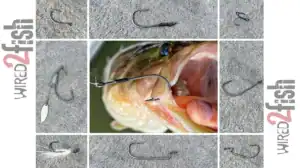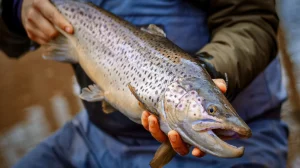The big worm is not a new bait for bass fishing, but it seems like there have been new twists, shapes, colors and places that big worms are getting applied across the country. Recently, some major tournaments have been won fishing big worms. And they’re not always on fisheries you’d expect. But that might be why more people don’t throw it in more places and more applications.
We paneled three of the sports best worm anglers to understand the nuances that go into their decision making, application and technique with big worms. Stacey King has been on a terror this year, finishing second in two FLW Tour events this year plus winning the PAA tournament on his home waters of Table Rock Lake, with some really big worms.
Mike McClelland is an old dragger, who grew up throwing big worms in the summer through standing timber and deep cover and has applied it all over the country with great success. He also, subsequently finished second in that Table Rock PAA tournament, with a big worm, and his tip on slowing down and letting the worm sit, lead to King’s big limit the final day.
Terry Bolton is known for his prowess on river ledges and summer bass, and his go to bait is a big worm. In fact he calls it his “comfort bait”, but he also blames its effectiveness on not being open minded enough when it wasn’t catching the right quality to change.
There are a bunch of great worm fishermen, skilled at making fishing bite these oversized offerings, but we wanted to get a sample from guys who are known for their big worm prowess and have had good success on it in recent years.
What’s Big
So what constitutes a “big” worm? Does it have to be over a certain length? Or does it just mean bigger than normal.
“I don’t throw worms much bigger than 10 1/2 inches,” Bolton said. “It’s big enough to catch a big one and it can catch a lot of keepers too.”
Mclelland too likes the 10 1/2-inch variety of the Zoom Ol’ Monster but is also looking forward to the 12-inch version because he has definitely been on fisheries where a 12-inch or bigger worm would have caught them.
“I know a lot of guys throw 9 1/2 and 10 1/2 inch worms, and I do too, but 12 inches and bigger are what I really consider big worms,” said Stacey King. “I’ve been throwing the 12-inch Bass Pro Shops Squirmin Worm for years and actually started throwing the Go2Baits 13- and 14-inch worms this year and have caught a lot of bass on them. Not to mention they helped me win the PAA event on Table Rock.”
Big is relative to the fishery. If you’re on a lake that has a population of quality fish, then a big worm can really dial in the big bites.
When to Go Big
About the time the bass get done with the spawn, the big worm starts to have an impact, and all three anglers believe there is a little lull period before it gets really prime time for big worm fishing when the fish start grouping up and feeling recovered after the spawn.
“Where I fish, it usually starts the third or fourth week of May or maybe the first of June,” said Bolton. “There is a period when they first start moving out and they don’t feel real good after the spawn, and the worm bite is hit or miss. Then it seems like overnight, it will just turn on and that’s when it’s the best of the season.”
King and McClelland both agreed and all three will start fishing the big worm post spawn but will continue throwing it all the way into the fall. About the time the shad start migrating to the creeks, the big worm bite will start to give way to other more productive techniques. But any time the water is warm or hot a worm can really get the fish to cooperate and that small narrow profile even at 10 or 12 inches can seem like a big but easy to eat meal.
“I know it’s going to happen every year because I’ve done it year after year,” King said.
Where to Probe
In talking with the three pros, we noticed a lot of trends among good worm anglers, and then some facets of it they diverged in their philosophies. On where to fish the worm, they all seemed to agree that a big worm is good anywhere there is a population of 3-pound bass or bigger. You’ll catch a lot of 1 and 2 pound bass on a big worm, but it’s still a big fish bait. If your fishery has a lot of small forage and lot of 1 and 2 pound bass, there may be other better techniques.
But all will fish them on points, humps, ledges, standing timber, grass or any place where they think schools of bass will gang up and any place they think a big bass would lurk.
“One thing I’ve learned over the years of fishing offshore is the fish are where we find them, and usually not where we want them to be,” King said.
King uses his worm as a search bait. He likes to make very long casts and sometimes he’ll swim it slowly along the bottom. Other times, he’ll just drag it, and still at other times he’ll employ a lift and drop technique, especially around standing timber or grass. But usually when he’s searching for active bass, he’ll fish the worm pretty fast.
McClelland on the other hand likes to use a big worm for a targeted approach.
“I’m a little more target specific offshore with a Texas-rigged big worm,” McClelland said. “I think I can cover water better with a football jig, but I can fish a big worm better on a specific target offshore. “
He spends a lot of time on his Lowrance HDS units with Structure Scan and finds rock piles, boulders, standing timber and other sweet spots on offshore structure, and then he uses the worm to pick them apart.
Bolton fishes from points to ledges and every where in between, regardless of cover.
All agree that the big worm is a great bait in any water clarity other than ultra clear water. King and McClelland really opened a lot of angler’s eyes with their performance on Table Rock Lake, an ultra clear fishery not known as a big worm lake. But this year’s massive floods added some much needed stain to the water that made it more conducive to big worm fishing.
How to Entice Bites
Triggering fish to bite is where the men are separated from the boys in terms of the catching and not catching bass. All three anglers have more than one retrieve they will regularly use to tempt fish. It’s still a trial and error but they do have differing opinions on how to fish the worm.
Stacey King came up watching Tommy Martin and those Texas guys around Toledo Bend fishing big worms and learned to fish the worms, in what he calls the “right way.”
http://fishpaa.com
“I always fish a worm with my rod tip up with semi-slack line,” King said. “I see my co-anglers fish with their rod tip pointed at the water. What happens is when a fish bites, you can’t give that fish any slack and he feels your tension when he hits the worm. With my rod tip up and semi slack line, I see the line jump, and I lower my rod tip to give them the worm for a second before I crack them pretty hard.”
Bolton learned to fish a worm much the same, but how the worm moved was the most critical part he learned.
“When I was coming up fishing in the 80s and 90s, there was an angler Britt Cone on Kentucky Lake who was winning every tournament on the lake for a stretch with a big worm,” Bolton said. “Cone would lift and drop the worm a lot and really get the fish to react to the worm. No matter how I fish it now, it’s all about contacting the bottom. Some guys fish it so fast they never make that bottom contact. I call it picking it up and setting it down.
“I think people have a tendency to overfish a big worm,” McClelland said. “The closer and more you keep it to the bottom, the better. There are 3-6 inches of the tail that are dancing around even when it’s sitting on the bottom without you moving it. It creates a lot of action on its own in the current.”
Both King and Bolton are of the notion that a lift and drop can trigger fish with a lighter weight on controlled slack line. And both McClelland and Bolton believe a heavier weight and just dragging it as slow as possible, or “counting rocks” as they like to call it, with a heavier weight is also effective.
Around grass they all three like to either use a light weight to pull around the edges of the grass and up over the grass because bass have a tendency to suspend in the grass in summer months. Or they will go to the other extreme and use a heavier weight to punch into the grass or to fish the deeper edge outs of the grass. A heavier weight will cause the worm to grab and pull the grass so shorter pitches with a heavy weight and longer casts with a much lighter weight.
Tackling Big Worm Tackle
This is where the path seems to split for the anglers a bit. The two philosophies in tackle really differ at the discussion of line size.
On the one side you have King and McClelland who rarely go below 17-pound fluorocarbon and often use 20-pound. They want big line because they plan to be fighting big fish around cover, rocks and more and want the fluorocarbon so there is no stretch when you set the hook.
McClelland likes 20-pound Sunline Shooter as his fluorocarbon of choice. He will sometimes go down to 16-pound Shooter if he’s fishing deeper than 20 feet because he feels a smaller diameter keeps him in better bottom contact in deeper water. King likes 17 pound fluoro and will go up to 25 pound fluoro around grass and cover and sometimes even braid in heavy vegetation.
Bolton however almost always stays with 12-pound fluorocarbon.
“I throw 12-pound Sufix Fluorocarbon line 95 percent of the time,” Bolton said. “I’m big on line diameter. I like a worm to go back to the bottom straight as it can, and I don’t want that drag of bigger diameter line. I even go down to 10 in deeper water. I think you get more strikes. You’ve got to be more careful about retying, playing the fish, etc. It doesn’t make as big a difference when you drag a worm as it does when you’re hopping it or lifting it.”
| King’s Tackle | 7-foot Heavy-action Bass Pro Shops Carbon Lite Rod 6.4:1 BPS Johnny Morris Signature Series Reel 17 to 20-pound Fluorocarbon line 5/0 Round bend Gamakatsu or EWG on bigger worms 1/2-ounce weight with Parasite Clip keeper Bass Pro 12-inch Squirmin Worm, Berkley Power Worm, Go2Baits 13-inch Paddle Tail |
| McClelland’s Tackle |
7-foot, 4-inch Heavy Action Micro Guide Falcon rod |
| Bolton’s Tackle |
7-foot Medium-Heavy Action Denali Rod |
Hooking Up
Another aspect of worm fishing that the anglers have varying opinions about is the hookset with a big worm. Is it better to set the hook as hard as you can or lean into them like a Carolina rig sweep set?
McClelland is of the latter opinion.
“To me the biggest thing about fishing a big worm is how you set the hook,” McClelland said. “Everyone thinks you have to jerk as hard as you can. When I rig a big worm, I Tex-pose the hook so that I don’t have to set the hook like crazy. Jeff Kriet and I have worked on this and traded notes. If you use the right line, like a good fluorocarbon like Sunline Shooter, you can almost just wind them in. We have a tendency to reel down and use a dramatic hooksets when a fish really hits it hard. But I miss so many more fish with those big hooksets. The key is the line. Good fluorocarbon will give you that ability to just lean into them and get a good hookset. “
King, however, likes the high rod approach so he can drop his rod and give the fish slack and then reel down and jack them pretty hard. Bolton is somewhere in the middle with a high-rod but he’s quick to set a fast hook when he’s sure a fish has taken the worm.
Big Worm Potpourri
There are literally hundreds of options for big worms now. From 9 ½ inch worms up to 17-inch worms. And the color options, actions and custom shapes and materials just keep getting better. Worms like the Zoom Ol’ Monster, Yum Ribbontail, and Mann’s Jelly Worms have been staples with anglers for decades.
“I caught a lot of fish on a paddle tail,” King said. “It’s buoyant and floats up and just dances around even when it’s just sitting there. When they want that upward posture it really produces. I caught all my weigh fish on it that final day at the PAA on Table Rock.”
There are just a plethora of other options and most of them are great.
“Scent is a big deal for me fishing big worms,” McClelland said. “I take a Hefty Quart bag with a handful of worms I’m going to throw and put some Smelly Jelly in the bag with them. When I Start throwing the worm over and over in that area, the scent is dispersing in the area. It may attract bass, but I think it also keeps smaller fish in the area and gets them excited, which in turn draws the bass.”
Then there is the matter of color. Strangely enough these anglers were very similar in colors. Bolton for instance fishes Plum a lot in cleaner water and Junebug in darker or off-colored water or cloudy days. He’ll also carry regional colors that are popular on specific fisheries.
King has his favorites. He likes Redbug a lot as well as green pumpkin and Blue Fleck in a Berkley Power Worm is one he’s caught fish on for years.
He summed up big worm fishing best:
“I’ll tell you what … I’ve caught so many big fish in my lifetime on big worms. It’s a technique that everyone who loves bass fishing needs to add to their arsenal if they want to catch some big fish. I’ve fished them in a lot of places all over the country. They are good in most places you consider offshore in the summer and a lot of places you might not consider like working it up and down in standing timber.
“The best way to gain confidence with a big worm is to get on a school of bass with any lure or technique and then pull out the big worm and see if you can’t catch a bigger fish on it. Once you see how effective it is, you’ll be anticipating its prime time every year.



















